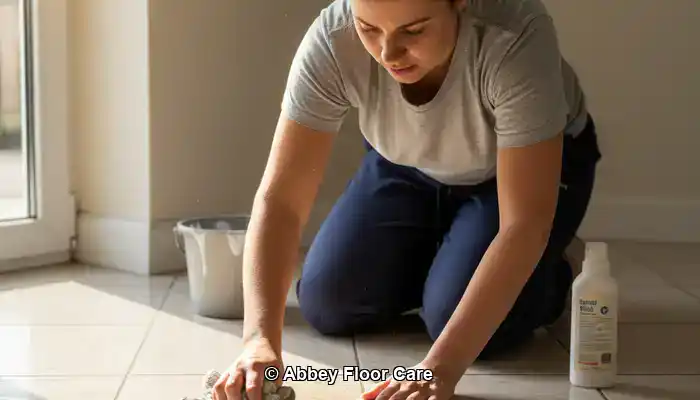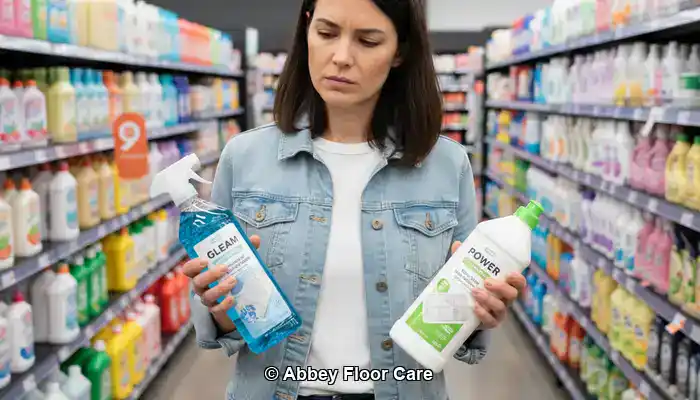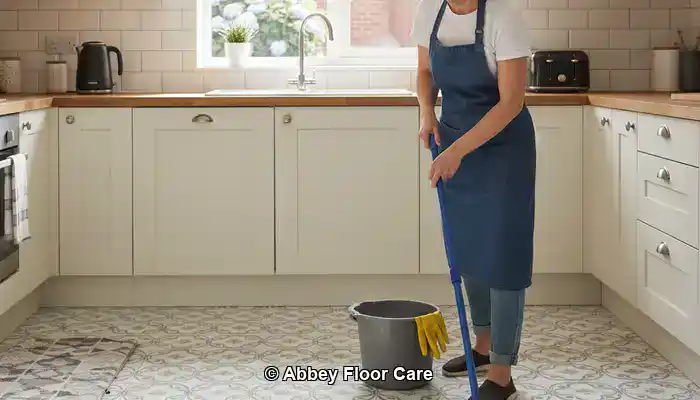
Ceramic Tile Floor Cleaning Services Near Me West Horsley
Key takeaways from your article on “Ceramic Tile Floor Cleaning Services Near Me West Horsley”:
- ✅ Use pH-neutral, tile-safe cleaners to avoid damaging the glaze or eroding grout over time.
- 🧽 Microfibre mops and soft brushes are best for lifting dirt without scratching ceramic surfaces or pushing debris into joints.
- 🚫 Avoid bleach, vinegar, and abrasive tools, which can cause discolouration, streaks, or surface wear.
- 💧 Grout needs separate care with gentler products to prevent erosion and maintain a consistent floor appearance.
- 🛠️ Professional cleaning and periodic grout sealing help restore dull tiles and extend the life of high-traffic floors.
Understanding Ceramic Tile Flooring in Surrey Homes

Common Types of Ceramic Tiles Used in Kitchens and Bathrooms
Ceramic tiles are a popular choice in Surrey homes, especially in kitchens, bathrooms, and hallways, where durability and water resistance matter. Most ceramic tiles are either glazed or unglazed. Glazed tiles have a protective coating that resists stains and moisture, while unglazed tiles offer a more natural, matte finish but require more frequent sealing.
Homeowners often choose ceramic for its versatility in colour, texture, and layout. Whether it’s a polished tile in a modern kitchen or a rustic matte tile in a country-style bathroom, the cleaning approach should match the tile’s surface and finish.
How Ceramic Differs from Porcelain and Natural Stone
Ceramic tiles are made from clay fired at lower temperatures than porcelain, making them slightly more porous and less dense. This means they can absorb more moisture if left unsealed, especially in high-humidity areas. Unlike natural stone, ceramic doesn’t have mineral layers or veining, so it’s less prone to etching but still vulnerable to surface wear if cleaned improperly.
Understanding these differences helps homeowners choose cleaning products and techniques that are suited to ceramic specifically, rather than relying on advice intended for stone or porcelain.
Why Grout and Tile Need Separate Care
Grout lines between ceramic tiles are often more porous than the tiles themselves. They absorb moisture and dirt more readily, so they require separate attention during cleaning. Using the same products on both surfaces can lead to uneven results — streaks on tiles or grout erosion.
To maintain a consistent appearance, use a tile-safe cleaner on the ceramic surface and a gentler, grout-compatible solution on the joints. This dual approach helps preserve the floor’s appearance and integrity over time.
Choosing the Right Cleaning Products for Ceramic Tiles

What Makes a Cleaner Tile-Safe
Ceramic tiles are durable, but not all cleaning products are suitable for them. A tile-safe cleaner should be pH-neutral, non-abrasive, and free from harsh acids or alkalis. These qualities help remove dirt without damaging the glaze or leaving a dulling film.
Checking the label for “safe for ceramic” or “pH-neutral” is a simple way to avoid products that could compromise the tile’s finish over time.
Avoiding Acidic or Abrasive Products
Cleaners containing vinegar, bleach, or ammonia may seem practical, but they can erode grout and damage the tile’s surface. Abrasive powders or scouring pads can scratch glazed finishes, making the floor harder to clean in the future.
Using these products regularly may lead to discolouration, patchiness, or a gritty texture that traps more dirt than it removes.
Recommended pH-Neutral Solutions
Look for cleaners formulated explicitly for ceramic or hard surfaces. These are designed to lift everyday grime without affecting the tile’s protective layer. Many come in concentrated form and can be diluted for regular use, making them both practical and economical.
Using the right solution helps maintain the tile’s original appearance and reduces the risk of streaks or residue after drying.
Eco-Friendly Options for Family Homes
For households with children, pets, or sensitivities to strong scents, eco-friendly tile cleaners offer a safer alternative. These products often use plant-based ingredients and avoid synthetic fragrances or dyes.
As with any cleaner, it’s essential to confirm that the product is pH-neutral and suitable for ceramic surfaces. Eco-friendly does not always mean tile-safe, so a quick check of the label can prevent unintended damage.
Step-by-Step Cleaning Method for Ceramic Tile Floors

Daily Sweeping and Dry Dusting
Loose dirt and grit can scratch ceramic tiles over time, especially in busy areas like kitchens and hallways. A soft broom or microfibre dust mop helps remove debris without damaging the surface. Dry dusting also prevents particles from settling into grout lines, making weekly cleaning more effective.
Weekly Mopping with Tile-Safe Detergent
Once a week, mop the floor with a pH-neutral cleaner diluted according to the label instructions. Avoid soaking the tiles — excess water can seep into grout and weaken the bond over time. Use a microfibre mop and change the water regularly to prevent streaks or residue.
After mopping, rinse with clean water and dry with a soft cloth to preserve the tile’s finish and prevent water spots.
Deep Cleaning for Textured or Matte Tiles
Textured ceramic tiles or matte finishes may hold onto grime more stubbornly. For deep cleaning, use a soft-bristle brush and a tile-safe solution to scrub the surface gently. Focus on areas near cookers, sinks, or entryways where buildup is more common.
Avoid harsh scrubbing or abrasive pads, which can wear down the glaze or leave visible marks.
How to Clean Grout Lines Without Erosion
Grout requires a gentler approach than tile. Use a diluted stone-safe or grout-specific cleaner, along with a soft brush, to lift dirt without damaging the joints. Avoid bleach or acidic products, which can cause discolouration or erosion over time.
Rinse thoroughly and dry the area to prevent moisture from settling into the grout. Regular gentle cleaning helps maintain the grout and the floor’s overall appearance.
Tools and Techniques That Protect Ceramic Surfaces
Microfibre Mops vs. Sponge Mops
Microfibre mops are ideal for ceramic tiles because they trap dust and lift grime without pushing debris into grout lines. Sponge mops, while common, tend to leave streaks and can push dirty water into joints, making grout harder to clean over time.
Choosing the right mop helps maintain the tile’s finish and reduces the need for frequent deep cleaning.
Steam Cleaning Risks and Alternatives
Steam cleaners may seem efficient, but they can force moisture into grout and beneath tiles, especially if the floor isn’t fully sealed. This can weaken adhesive bonds and lead to long-term issues. For safer results, use a damp mop with a tile-safe cleaner and avoid high heat or pressure.
Using Soft Brushes for Grout and Edges
Grout lines and tile edges collect more dirt than flat surfaces. A soft-bristle brush allows targeted cleaning without scratching the glaze or eroding grout. This is especially useful in corners, around appliances, and near entryways where buildup is common.
Brush gently and rinse thoroughly to prevent residue from settling back into the joints.
Drying Methods to Prevent Streaks
After cleaning, drying the floor properly helps prevent streaks and water spots. Use a clean microfibre cloth or dry mop to absorb excess moisture. This step is crucial for glazed tiles, which can show streaks more easily under natural light.
Drying also helps protect grout from prolonged exposure to moisture, preserving its colour and structure.
When to Consider Professional Tile Cleaning Services
Signs of Wear, Staining, or Residue
If your ceramic tile floor looks dull, feels sticky, or shows uneven patches after cleaning, it may be time to consider professional help. These signs often indicate that residue has built up or that the grout has absorbed moisture and dirt over time. High-traffic areas like hallways and kitchens tend to show wear more quickly.
Professional cleaning can restore the tile’s original finish and remove embedded grime that regular methods may miss.
What Professional Cleaning Includes
Professional tile cleaning typically involves deep cleaning with tile-safe solutions, targeted grout treatment, and optional resealing. Technicians may use low-moisture equipment and specialised brushes to lift dirt without damaging the surface. The goal is to restore the floor’s appearance while protecting its long-term integrity.
How to Choose a Local Service in West Horsley
When selecting a cleaning service, look for providers who specialise in complex surface care and understand the needs of ceramic flooring. Ask about their cleaning methods, the products they use, and whether they offer grout-safe options. A good provider should be able to explain their process clearly and offer examples of past work.
In West Horsley, many homeowners prefer services that offer maintenance plans or follow-up support, especially for tiled areas that are frequently used.
Benefits of Periodic Sealing and Polishing
While ceramic tiles don’t always require sealing, grout lines often do. Periodic sealing helps prevent staining and moisture absorption, especially in kitchens and bathrooms. Polishing may also be used to enhance the appearance of glazed tiles and reduce surface dullness.
Scheduling maintenance every 1 to 2 years can help preserve the floor’s finish and reduce the need for intensive restoration later on.
FAQs About Ceramic Tile Floor Cleaning
Can I Use Bleach or Vinegar on Ceramic Tiles?
It’s best to avoid bleach, vinegar, and other acidic cleaners on ceramic tiles. These products can erode grout, dull glazed finishes, and leave behind residue that’s difficult to remove. A pH-neutral cleaner is safer and more effective for regular use.
How Often Should I Clean and Reseal?
Daily sweeping and weekly mopping are usually enough for maintenance. Deep cleaning may be needed every few months, especially in busy areas. While ceramic tiles themselves don’t always require sealing, grout lines should be resealed every 1 to 2 years to prevent staining and moisture absorption.
What If My Tiles Look Dull After Cleaning?
Dullness can result from leftover residue or using incompatible cleaning products. Try rinsing with clean water and drying with a microfibre cloth. If the problem persists, consider switching to a stone-safe or tile-specific cleaner and avoid layering multiple products.
Is Ceramic Suitable for Underfloor Heating?
Yes, ceramic tiles are compatible with underfloor heating systems. They conduct heat efficiently and maintain a stable surface temperature. Just ensure the adhesive and grout used are rated for thermal expansion, and avoid overly wet cleaning methods that could affect the subfloor.
19 Willow Rd,
New Malden
KT3 3RS
(01372)-664-337
We work throughout the country, just some of our work counties:
Copyright © Abbey Floor Care. Natural Stone Floor Restoration in Surrey and South West London FAQ - Privacy Policy - Terms And Conditions
Abbey Floor Care is a participant in the Amazon Services LLC Associates Programme, an affiliate advertising programme designed to provide a means for websites to earn advertising fees by linking to Amazon.co.uk. As an Amazon Associate, we earn from qualifying purchases.